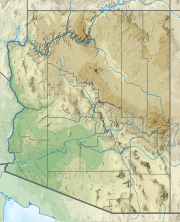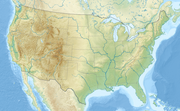| Tempe Butte | |
|---|---|
| "A" Mountain O'odham: ʼOidbaḍ Doʼag | |
 Tempe Butte, or A Mountain, is a popular place to hike as it provides a view of ASU's Tempe campus and downtown Tempe. Tempe Butte, or A Mountain, is a popular place to hike as it provides a view of ASU's Tempe campus and downtown Tempe. | |
| Highest point | |
| Elevation | 1,495 ft (456 m) NAVD 88 |
| Prominence | 330 ft (100 m) |
| Coordinates | 33°25′42″N 111°56′09″W / 33.428234536°N 111.935780928°W / 33.428234536; -111.935780928 |
| Geography | |
  | |
| Location | Tempe Maricopa County, Arizona, U.S. |
| Topo map | USGS Tempe |


Tempe Butte (O'odham: ʼOidbaḍ Doʼag) is the official name of an andesite butte of volcanic origin, located partially on Arizona State University's Tempe campus in Tempe, Arizona. It is often referred to by locals as A Mountain, after the 60-foot-tall (18 m) gold-painted letter 'A' near the top. Another name for the area, used by the City of Tempe, is Hayden Butte.
The highest point of Tempe Butte stands at 1,495 feet (456 m) in elevation, while its base is at approximately 1,150 feet (350 m) in elevation.
Tempe Butte is most often seen as the backdrop to games held in Mountain America Stadium (historically Sun Devil Stadium), including until recently the Tostitos Fiesta Bowl, as well as Super Bowl XXX.
Geography
| This section does not cite any sources. Please help improve this section by adding citations to reliable sources. Unsourced material may be challenged and removed. (December 2017) (Learn how and when to remove this message) |
Originally, Tempe Butte was part of a series of horizontal layers, but the strata have been tilted, associated with the formation of South Mountain, and millennia of erosion has created the distinctive hogback of resistant andesite, over sedimentary deposits and rhyolite beds.
Despite intensive development, the butte and its immediate surroundings continue to support a variety of native vegetation, including saguaro, buckhorn cholla, barrel cactus, creosote bush, wolfberry, mormon tea, sweetbush, desert lavender, California buckwheat, catclaw acacia, palo verde and mesquite. Springtime annuals include Coulter's and Arizona lupine (Lupinus sparsiflorus and Lupinus arizonicus), Coulter's globemallow (Sphaeralcea coulteri), popcorn flowers (Cryptantha), fiddlenecks (Amsinckia), heliotropes (Phacelia), blonde plantain (Plantago ovata) and others. During the summer wild buckwheat (Eriogonum deflexum) blooms, leaving behind a "skeleton" in the fall. The five-winged spiderling (Boerhavia intermedia) then becomes the dominant annual on this preserve and in neighboring Tempe. Native wildlife include jackrabbits, and small desert-adapted species such as pack rats.
History
Signs of early habitation by the Hohokam people have been found on Tempe Butte, including petroglyphs, pot shards, scrapers, and metate. "'Oidbaḍ Doʼag," the name used by the local Native Americans, means "Dead Field Mountain."
The area just west of the butte would be settled by the 1870s in an area first known as Hayden's Ferry, then a major crossing for the Salt River which flows just north of the butte. The proximity of the community to the butte prompted Darrell Duppa to fancifully compare the area to the Vale of Tempe near Mount Olympus in Greece; therefore, the town was given its present name. The remains of the Hayden Flour Mill (which lends its name to main thoroughfare Mill Avenue) still stand near the western edge of the butte.
More recent alterations include two water tanks on the south flank of the butte, and several trails, at least one paved, to provide access to man-made structures. The east side of the butte was partially excavated in order to accommodate the construction of Sun Devil Stadium in 1958. A 50-foot-tall (15 m) radio tower was built on the top of the mountain in 1962 for the Salt River Project.
In 1961, the City Council changed the mountain's name to "Hayden Butte," honoring early settler Charles T. Hayden (1825–1900) and his son, U.S. Senator Carl Hayden (1877–1972). The U.S. Geological Survey, however, continued to use the former name, "Tempe Butte."
In 1965, Arizona State University installed a concrete letter 'A' on the butte. The City of Tempe designated the area a "preserve" in 2002.
In May 2019 all towers and related materials were removed permanently by the city of Tempe. Recent development along the adjacent stretch of the Salt River (which has been dammed to form Tempe Town Lake) has prompted several grassroots movements to preserve the butte from further environmental damage.
Capital "A"
Originally, the letter on Tempe Butte was an 'N', built by Tempe Normal School's class of 1918. The school changed its name to Tempe State Teacher's College in 1925, and the 'N' was adapted into a 'T'. Subsequently, three years later, the school would change its name again to Arizona State Teacher's College. It wasn't until 1938 that an “A” first appeared. It was formed from loose rocks and soon after, the fall ritual of whitewashing the "A" began. In 1952, vandals with dynamite completely destroyed the "A." The latest "A," made of reinforced steel and poured concrete, was built in 1955. It is 60 feet from its base to its top.
Due to the existence of an "A Mountain" for the University of Arizona (Sentinel Peak) which predates the "A" on Tempe Butte, students from these rival schools often attempt to paint the other's 'A' in their school colors. Guarding the A is an annual ritual in the week leading up to the annual ASU-UA football game, the Territorial Cup. The A has been painted in other colors for various causes, and is painted white at the beginning of each school year, but is usually painted Gold, one of ASU's school colors. Most recently, UA students painted the A red and blue in November 2014, three weeks prior to their rivalry game. The A has also been painted colors by other schools, such as green by Oregon Ducks fans and purple by Grand Canyon University fans.
References
- ^ "Tempe Butte". NGS Data Sheet. National Geodetic Survey, National Oceanic and Atmospheric Administration, United States Department of Commerce. Retrieved February 9, 2014.
- "Tempe Butte, Arizona". Peakbagger.com. Retrieved February 9, 2014.
- ^ "Hayden Butte Preserve Management Plan". Tempe.gov. 2017. Retrieved April 8, 2021.
- ^ Branom, Mike (June 22, 2008). "Tempe Butte steps closer to historic register". East Valley Tribune. Retrieved April 8, 2021.
In 1961, the City Council changed the mountain's name to Hayden Butte, honoring Tempe's founder and his son, former U.S. Sen. Carl Hayden. However, the city never takes up the change with the U.S. Geological Survey, leading to the two names.
- "USGS Geological Survey Bulletin 845: Main Line, Picacho to Phoeniz and Wellton, Ariz". US Geological Survey. 2007. Retrieved April 8, 2021.
Just east of the bridge over the Salt River is Tempe Butte (see fig. 50), a prominent landmark due to a heavy mass of lava (andesite) lying on shale and sandstone, which with the lava is tilted to the southeast at an angle of 45° or more. The base is a massive sandstone quarried to some extent for building. The strata are more and more mixed with clay toward the top, where most of the material under the lava is red shale. More red sandstone in massive beds is exposed north of the river opposite Tempe; it grades down into a coarse granitic arkose or breccia lying on an irregular surface of old granite. It dips 65° NW., nearly at right angles to the dip of the exposure in Tempe Butte. This sandstone was found in a well 1-1/2 miles northeast of Tempe, but a well 2-1/2 miles northwest of the town was entirely in granite. Similar arkose and conglomerate lie on granite in Camelback Mountain, near Phoenix.
- "A-Mountain trails closed Friday due to radio towers being removed". FOX 10 Phoenix. May 24, 2019. Retrieved February 2, 2020.
- "What a : Developers and anti-growth activists want a piece of Tempe's mythical mountain". Phoenix New Times. May 11, 2000. Archived from the original on May 4, 2005. Retrieved February 8, 2014.
- "Hayden Butte Preserve Park". City of Tempe. Retrieved March 15, 2017.
- "Students restore 'A' Mountain after UA fans paint it blue". The State Press. November 21, 2011.
External links
- ASU Campus Tour: A Mountain
- Overview of Tempe Butte physical geography
- Description of Tempe Butte by Tempe Historic Property Register
- Tempe Butte on LoJ Lists of Peak
| Arizona State University | |||||||
|---|---|---|---|---|---|---|---|
| Located in: Tempe, Arizona | |||||||
| Academics |
| ||||||
| Campuses |
| ||||||
| Athletics |
| ||||||
| Media | |||||||
| Buildings | |||||||
| Other | |||||||
| |||||||